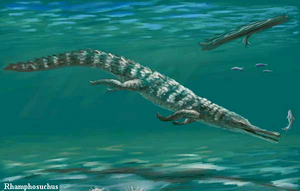| Rhamphosuchus | ||||
|---|---|---|---|---|

| ||||
| Name | Rhamphosuchus | |||
| Order | Crocodylia | |||
| Class | Reptilia | |||
| Name Translation | Beak-Crocodile | |||
| Period | Miocene | |||
| Location | India and Pakistan | |||
| Diet | Carnivore | |||
| Length | 11.4 m (36 ft) long | |||
Rhamphosuchus (ram-FOE-sue-KUSS) was a very large crocodilian that was closely related to the modern-day gharial. It was as long as Gryposuchus or Deinosuchus rugosus, but not as heavy.
Discovery[]
In 1840 a team of scientists lead by Falconer and Cautley were digging in the badlands of India. There they found the skull fragments of a massive crocodyliform. They tried to dig for more, but that was all they were able to find. They shipped the fragmentary bones over to an English museum and were proven to be in fact the jaw bones of a massive gharial-like crocodile. It was named Rhamphosuchus, or "beak crocodile" because its snout also formed a beak-like appearance. Back then it was considered to be the largest crocodile ever discovered, using old-fashioned estimations to make it nearly 18 meters (60 feet) long and 20 tons in weight. Since then, though, studies have suggested that its size is quite a bit smaller than that, but still a very large animal. Also, crocodiles like Mourasuchus, Deinosuchus, Purussaurus, and Sarcosuchus have dethroned it as largest crocodile and since then Rhamphosuchus has lost quite a lot of publicity.

Rhamphosuchus vs Man
Description[]
Rhamphosuchus had a long, beak-like snout (hence the name) with conical, gripping teeth, perferctly designed to catch large, slippery fish. It was a very good swimmer and was probably able to swim at failry fast paces to catch quick fish. It was one of the largest crocodilians to have ever lived, growing to a maximum of 11.4 meters (36 feet), completely outgrowing any living crocodile. They are the longest Cenozoic crocodilan that does not lived in Holocene Rhamphosuchus was perfectly designed for catching fish. The extended, narrow snout was barely visible in the murky rivers where it lived, and when its prey was least expecting it, it'd jump up and catch them by surprise, gripping them in its teeth and swallowing it shortly after.

Rhamphosuchus Skull

Artist's illustration of Ramphosuchus
It had a long, strong tail designed for efficient swimming, and also had short, stout legs, like all crocodilians. Like its modern-day cousin, the gharial, it had a long, narrow snout designed to catch slippery fish. It also had thick, leathery skin, designed for extra protection against rivals, such as other crocs.
References[]
http://en.wikipedia.org/wiki/Rhamphosuchus
http://dinosaurs.about.com/od/predinosaurreptiles/p/Rhamphosuchus.htm
http://www.prehistoric-wildlife.com/species/r/rhamphosuchus.html